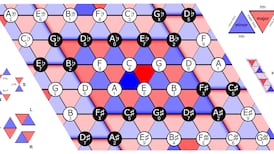SMALL PRINT:HUMAN ATHLETES have been achieving impressive feats of strength this summer at the London 2012 Olympics. But when it comes to insects, some aren't too shabby in the strength department either.
Horned passalus beetles, which are found in rotting hardwood logs in the US, are pretty strong – they can pull at least 100 times their own weight, according to a release from the University of Georgia, where undergraduate researchers have been finding out how physical attributes and environment can affect the might of the insects.
One project put the shiny beetles through their paces in a specially designed track and used equipment to log the strength of their pull.
It turns out that girth is the best predictor of pulling strength; the stockier the beetle, the more power it could generate with its legs, said project supervisor Andy Davis from UGA’s Odum School of Ecology. We were not expecting that.
Another unexpected finding came from looking at associations between the strength of the animals and their accommodation – in this case, solitary living seemed to result in beefier performances in the experiments.
We started to notice that beetles that were housed by themselves pulled better than those housed in groups, Davis said. We suspected that crowding was probably a source of stress for them. The studies are as yet unpublished.
Exoskeleton gives Emma ‘magic’ arms
THIS WEEK the news was awash with reports of unbridled happiness at Nasa when the Mars rover Curiosity landed safely on the red planet.
But there was another happy technology story doing the rounds too: one of a young girl who is able to use her arms thanks to a printed three-dimensional “exoskeleton”.
The child, Emma Lavelle, was born with arthrogryposis multiplex congenita (AMC), a condition where joints are stiff and muscles don’t develop fully. At age two she started using a Wilmington Robotic Exoskeleton (Wrex), a device that uses hinged bars and resistance bands to help people use their arms.
The assistive technology, which was developed at the Nemours/Alfred I. DuPont Hospital for Children in Wilmington, Delaware, allowed Emma to use her arms so she could play and hug, but due to the size and heaviness of the exoskeleton she could use it only in a workshop. So to make a smaller, lighter version for more “free-range” use, the engineers used a Stratasys 3D printer – which can build complex three-dimensional objects from computer designs – to print out components in ABS plastic, a material used in Lego. The scaled-down “arms” were then fixed to a plastic jacket that Emma could wear.
“The weight difference is significant and for a child who only weighs 25 lbs, it makes a big difference,” said Emma’s mother Megan in a video online, where she described how Emma called the Wrex her magic arms. “We are on our second jacket, she outgrew the first one . . . and it’s still evolving, it’s still growing into this incredible prosthetic that helps her to use her arms.” Megan Lavelle also described how if a part of the exoskeleton breaks, she can send a picture of it to the hospital and they can print out a replacement component.
Youtube search: Emma, magic, arms










